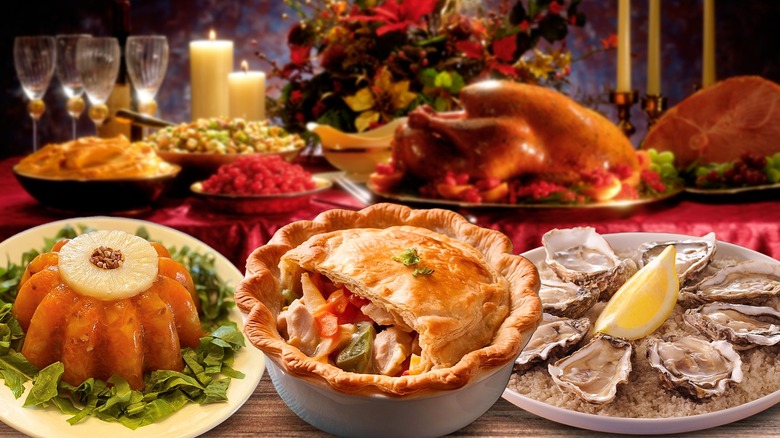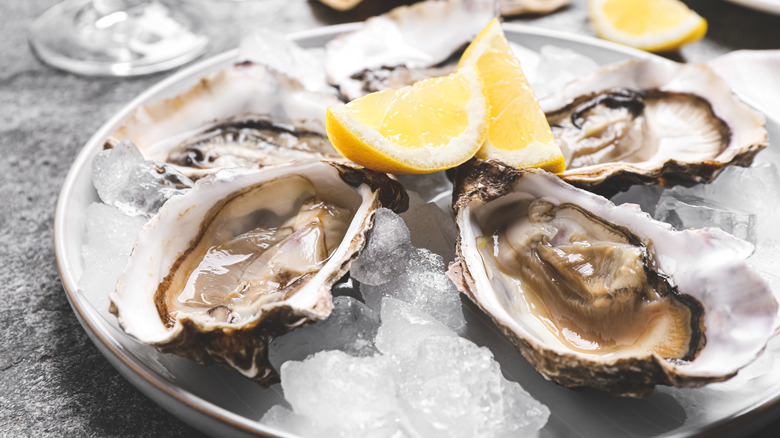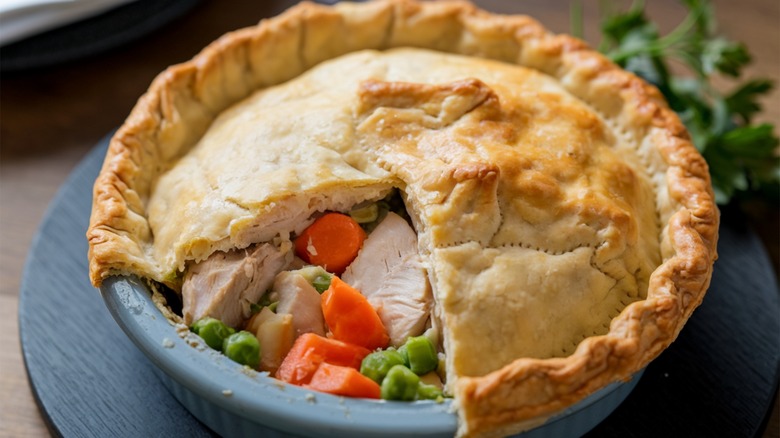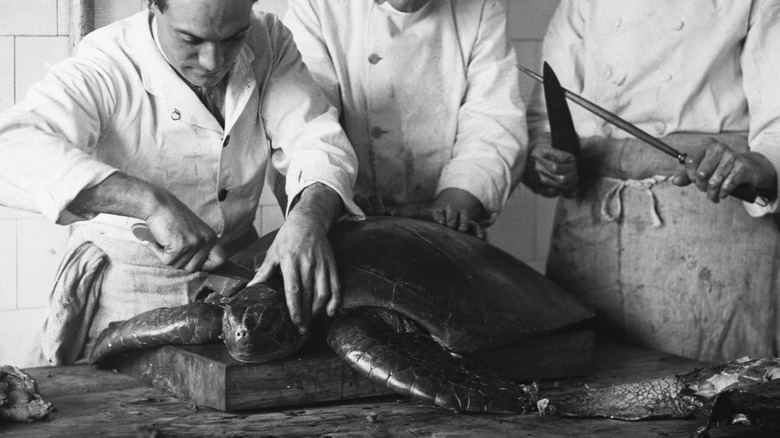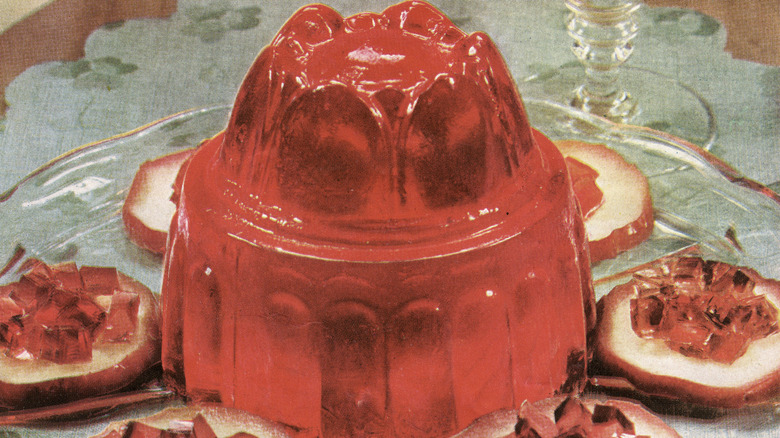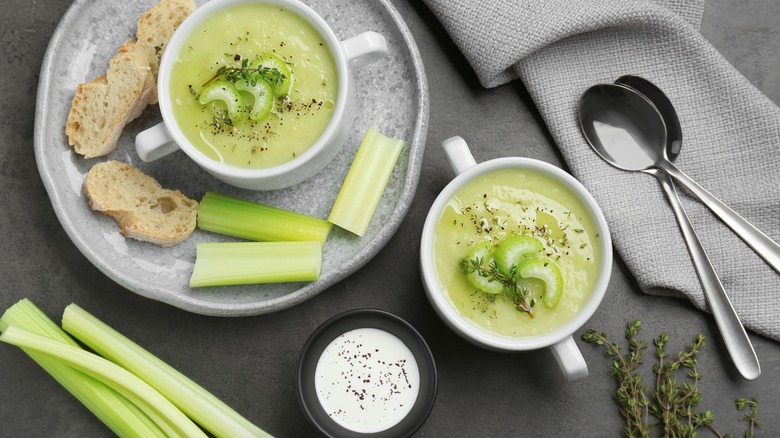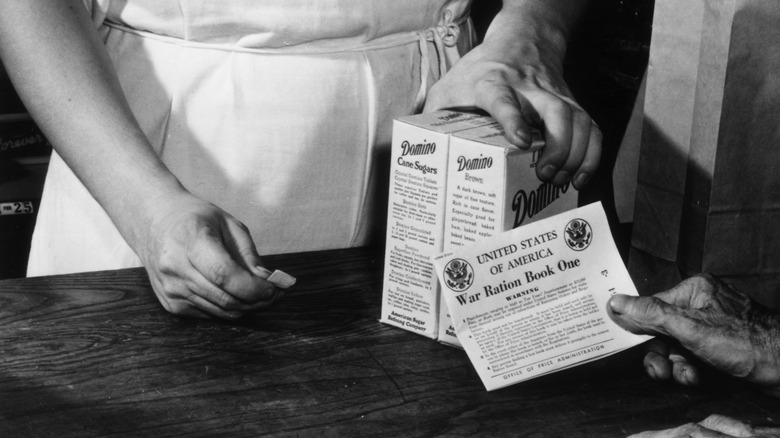8 Thanksgiving Dinner Traditions That Were Forgotten Over Time
With the fourth Thursday of November fast approaching, many Americans are eagerly anticipating their annual Thanksgiving day traditions. Of course, given the literal tons of food set to be consumed on the holiday from coast to coast, most of us are likely salivating over the day's delectable dinner — and with good reason. The list of culinary icons found on Thanksgiving menus is vast, including (but not limited to) turkey, stuffing, cranberry sauce, pumpkin pie, and turtle soup.
Wait ... that's not right. After all, it's Tur-key Day, not Tur-tle Soup Day. Yet once upon a time, turtle soup — yes: as in soup made with turtle meat — was as common on Thanksgiving dinner menus as mashed potatoes and gravy. In fact, the meal we know and love has evolved dramatically since the original feast back in 1621. And while some beverage selections from the first celebration remain the same, numerous other Thanksgiving traditions have been lost to time — as if they never existed at all.
From fads that have fallen out of favor, to items that were once popular more out of necessity than preference, plenty of previously prominent Thanksgiving dishes have disappeared from the public consciousness. With that in mind, we've compiled a list of now-defunct holiday meal components to save you a trip to Plymouth Rock. Here are eight Thanksgiving dinner traditions that were forgotten over time.
Oysters were once an essential Thanksgiving addition throughout the US
To be perfectly honest, while some no-longer-prominent Thanksgiving dinner traditions have been almost entirely erased, others actually remain — though often as a mere shell of their former selves. Look no further than the decline of oysters on Thanksgiving tables in every corner of the U.S. for proof. While oyster dressing (or stuffing) may still be a common regional dish in parts of the South, the shellfish's essential presence on early holiday tables has been largely forgotten.
Quite frankly, the absence of oysters as a Thanksgiving anchor in the 2020s is hardly surprising. Though they remained crucial to the holiday for many as late as 1956, a combination of factors (including increased regulation and health safety risks) drastically decreased the overall popularity of oysters as the 20th century moved forward. Perhaps folks attending an 1890s Thanksgiving dinner would be aghast to discover an absence of oysters. But it's unlikely to incur more than a shrug from many 21st century Americans, illustrating how oysters once-illustrious stature has diminished in modern eyes.
Chicken pie was a centerpiece dish on 19th century tables
No debate exists regarding the definitive Thanksgiving dessert option: There's pie — be it pumpkin, apple, pecan, or another variety — and then there's everything else. Of course, while the sweet versions of this pastry have been (and will remain) etched on Thanksgiving menus for years, most folks likely don't realize a savory poultry-based option once dominated the holiday. But it wasn't a turkey dish that graced dinner tables — it was chicken pie.
Now, conventional wisdom might suggest a dish served on a holiday commonly referred to as Turkey Day would incorporate the titular bird. But the general lack of readily available turkeys in many parts of the U.S. — combined with lingering regional resentment towards the North in the post-Civil War South — meant chicken was the preferred option for an opulent entree. As a result, chicken pie became a genuine Thanksgiving centerpiece for decades throughout the nation.
The dish was mainly consumed in Southern and Midwestern households. However, it was so well-associated with the holiday during the 19th century that it wasn't uncommon to find it on menus in Northern states, as well. With that in mind, consider preparing an homage to our ancestors over the long holiday weekend with a leftover turkey pot pie.
Turtle soup was a holiday dinner tradition before its popularity declined
The world's ever-changing attitude towards which types of animals are (and are not) culturally acceptable to eat means many previously popular protein sources are apt to raise a few eyebrows among modern diners. Case in point: Turtle soup, a dish once so highly regarded by the American populace that it was allegedly served to John Adams on July 4, 1776 in celebration of our nation's original Independence Day. Of course, the widely enjoyed soup wasn't solely reserved for the 4th of July, as it was also a Thanksgiving dinner tradition during the holiday's early years.
It's not exactly surprising to discover turtle soup was an essential component of the November holiday until the early part of the 1900s. While it may seem callous to consider consuming Leonardo or Raphael, the culinary usage of terrapins was once widespread enough that President Theodore Roosevelt even served turtle (likely in soup) at the White House for Thanksgiving in 1903.
Since the overwhelming popularity of turtle soup eventually led to the near extinction of the alligator snapping turtle, the dish fell off the map as the 20th century progressed. Consequently, turtle soup vanished from Thanksgiving menus, making it one more holiday tradition forgotten with time.
So-called salads prepared in gelatin molds were a mid-20th century fixture
Throughout history, the desire for convenience among consumers has led to some truly unbelievable trends. Yet when it comes to sheer oddity, no culinary technique or approach may top supposed salads made in gelatin molds with packets of Jell-O. Of course, while the heyday of gelatin mold salads is long gone, these baffling side dishes were once commonplace at Thanksgiving dinners.
Now, despite the borderline nauseating appearance of an enormous, jiggling mountain of Jell-O — with who-knows-what suspended inside — we can actually admit we sort of see the appeal. They were a supremely cost-effective option for budget-minded families, and almost stunningly easy to prepare. Who could complain when all that's required is combining a pre-made Jell-O mix with fruit or vegetable pieces in a gelatin mold, then simply waiting for it to solidify?
Quite frankly, between its unbeatable cost, ease of preparation, and ostentatious presentation, there's also something wholly American about a gelatin mold salad. We can't say we're disappointed they're akin to liver and onions nowadays: an unusual-yet-historic culinary footnote. But as a slice of mid-20th century Americana, we hope Jell-O salads' former Thanksgiving glory is never entirely forgotten.
Turkey wasn't always the sole poultry star
If you polled 100 people, and asked them which food best embodies the Thanksgiving spirit, we'd bet dollars to donuts most would answer turkey. Yet the act of gobbling down this gobbling bird wasn't always a given on the holiday. In fact, a variety of poultry (either in lieu of or alongside turkey) was often served for the feast in the past, including geese, ducks, and even passenger pigeons.
The presence of additional poultry options beyond turkey extends back to the first Thanksgiving. While that days-long 17th century celebration likely included turkey, it almost certainly featured a plethora of additional bird-derived proteins, as well (along with a hefty serving of venison). Additionally, when the Founding Fathers revived the Thanksgiving holiday during the earliest years of our nation, turkey was hardly the only poultry traditionally enjoyed.
Of course, turkey eventually came to dominate Thanksgiving dinner menus by the mid-19th century. And given the iron grip turkey has gained on the holiday, you can presumably forget about any other birds becoming a companion centerpiece in the future.
Both fresh and cooked celery was prominent at Thanksgiving for decades
While some folks aren't concerned about the undeniably excessive nature of most Thanksgiving dinner items, others are apt to enjoy a bit of fresh (or minimally prepared) produce to balance the bevy of richness. With this in mind, it's sort of understandable why diners might want to munch on some celery sticks over the course of their Thanksgiving gluttony. But even the world's biggest celery fan might be surprised to discover the water-dense veggie was considered a Thanksgiving dinner requirement for decades.
Since the consumption of raw veggies was rare during the 19th century, the presence of fresh celery at Thanksgiving helped mark the day as a special occasion. It wasn't just raw celery, though, as a variety of cooked celery dishes were prominently found on old school Thanksgiving menus, as well — further indicating the vegetable was a Thanksgiving dinner tradition on par with sweet potato casserole until the middle of the 20th century.
Perhaps you'll find some raw celery sticks on a crudité platter at a modern Thanksgiving party. But seeing how celery's star has dimmed considerably around the U.S. over the years, you'll never again find it dominating menus.
Sugar rations made Thanksgiving desserts notably less sweet during both world wars
Living in a society, we're expected to sacrifice our own personal satisfaction at times in order to provide for the greater good. This is particularly crucial during times of crisis, as the U.S. population discovered during both World War I and World War II. In fact, in order to ensure supplies were available for troops fighting across the Atlantic, the government imposed rations on various foods, including sugar. Consequently, pumpkin pies, apple pies, and Thanksgiving desserts of all kinds were traditionally less sweet during both 20th century world wars.
Now, we'd like to imagine every individual is well-acquainted with history (so we're not doomed to repeat it, of course), and is aware of the wartime tradition of notably less sweet pies on Thanksgiving. But it's also easy to believe the vast majority of people have forgotten — or never even learned — about the saccharine sacrifices made by holiday bakers during the 1910s and '40s. No one likes to prioritize remembering the bad times over the better ones, after all.
Additionally, even though a variety of cookbooks and suggestions were offered to help offset the decrease in available sugar during both wars, we're sure those pies paled in comparison to the full-sugar creations. On second thought, then, it's no wonder this Thanksgiving dinner tradition has been forgotten over time.
Mincemeat pie (perhaps made with actual meat) was a staple pastry
Like oysters in stuffing, mincemeat pie hasn't exactly been forgotten. After all, there appear to be plenty of instances where mincemeat pie remains an option in the 21st century (perhaps as the favorite dessert of your 97-year-old grandmother). But what has been forgotten by most of the world is that the name "mincemeat" wasn't always a misnomer — and the traditional Thanksgiving pie almost certainly contained actual meat when served at holiday celebrations in centuries past.
As you presumably already guessed (or knew), mincemeat doesn't actually contain meat in the modern world. Yet the origin of the name is indeed based on an antiquated technique for preserving meat in sugar, alcohol, and spices. Given this, any mincemeat pies served before 1900 (and prior to the rise of modern preservation methods) may have been a bit more savory than you'd expect in the 2020s.
Of course, while the name stuck around, the inclusion of mincemeat's secondary namesake eventually ceased. So if you decide to take inspiration from the Victorian era and bake an all-fruit mincemeat pie for the holiday, be thankful the use of meat in your recipe is little more than a piece of trivia.
